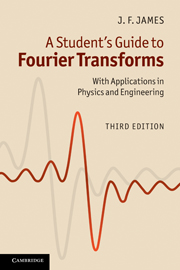Book contents
- Frontmatter
- Contents
- Preface to the first edition
- Preface to the second edition
- Preface to the third edition
- 1 Physics and Fourier transforms
- 2 Useful properties and theorems
- 3 Applications 1: Fraunhofer diffraction
- 4 Applications 2: signal analysis and communication theory
- 5 Applications 3: interference spectroscopy and spectral line shapes
- 6 Two-dimensional Fourier transforms
- 7 Multi-dimensional Fourier transforms
- 8 The formal complex Fourier transform
- 9 Discrete and digital Fourier transforms
- Appendix
- Bibliography
- Index
Preface to the first edition
Published online by Cambridge University Press: 05 June 2012
- Frontmatter
- Contents
- Preface to the first edition
- Preface to the second edition
- Preface to the third edition
- 1 Physics and Fourier transforms
- 2 Useful properties and theorems
- 3 Applications 1: Fraunhofer diffraction
- 4 Applications 2: signal analysis and communication theory
- 5 Applications 3: interference spectroscopy and spectral line shapes
- 6 Two-dimensional Fourier transforms
- 7 Multi-dimensional Fourier transforms
- 8 The formal complex Fourier transform
- 9 Discrete and digital Fourier transforms
- Appendix
- Bibliography
- Index
Summary
Showing a Fourier transform to a physics student generally produces the same reaction as showing a crucifix to Count Dracula. This may be because the subject tends to be taught by theorists who themselves use Fourier methods to solve otherwise intractable differential equations. The result is often a heavy load of mathematical analysis.
This need not be so. Engineers and practical physicists use Fourier theory in quite another way: to treat experimental data, to extract information from noisy signals, to design electrical filters, to ‘clean’ TV pictures and for many similar practical tasks. The transforms are done digitally and there is a minimum of mathematics involved.
The chief tools of the trade are the theorems in Chapter 2, and an easy familiarity with these is the way to mastery of the subject. In spite of the forest of integration signs throughout the book there is in fact very little integration done and most of that is at high-school level. There are one or two excursions in places to show the breadth of power that the method can give. These are not pursued to any length but are intended to whet the appetite of those who want to follow more theoretical paths.
The book is deliberately incomplete. Many topics are missing and there is no attempt to explain everything: but I have left, here and there, what I hope are tempting clues to stimulate the reader into looking further; and of course, there is a bibliography at the end.
Information
- Type
- Chapter
- Information
- A Student's Guide to Fourier TransformsWith Applications in Physics and Engineering, pp. ix - xPublisher: Cambridge University PressPrint publication year: 2011
